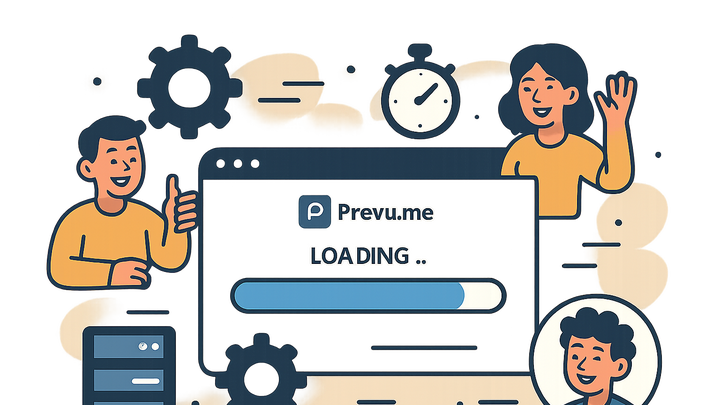Published on 2025-06-29T22:20:27Z
What is Load Time Optimization? Boosting CRO, UX, and SEO
Load Time Optimization is the practice of improving a website’s loading speed to enhance user experience, boost conversion rates, and improve search engine rankings. In website criticism for CRO, UX, and SEO contexts, load time is a critical factor that influences bounce rates, engagement, and revenue. By analyzing performance metrics such as Time to First Byte (TTFB), First Contentful Paint (FCP), and Largest Contentful Paint (LCP), teams can identify bottlenecks and implement targeted improvements. Effective strategies include optimizing images, minifying code, leveraging browser caching, and using Content Delivery Networks (CDNs). Tools like Prevue.me provide comprehensive audits and actionable critiques to streamline optimizations across performance, accessibility, and conversion elements. This article explores why load time matters, key metrics, best practices, and SaaS solutions to accelerate your site.
Load time optimization
Load Time Optimization improves website speed to boost conversions, usability, and search rankings.
Why Load Time Optimization Matters
Fast-loading websites deliver better user experiences, leading to higher engagement, lower bounce rates, and increased conversions. Search engines prioritize speedy pages, making performance a key SEO ranking factor. In CRO and UX audits, slow load times often correlate with lost leads and frustrated visitors. Prioritizing optimization helps businesses retain users and generate more revenue.
-
Conversion rates
Research shows that each additional second of load time can reduce conversion rates by up to 7%. Improving speed directly impacts lead generation and sales.
- Bounce reduction:
Faster pages keep users engaged, decreasing the likelihood of immediate exits.
- Checkout completion:
Streamlined loading during checkout reduces cart abandonment.
- Bounce reduction:
-
Search engine rankings
Google’s Core Web Vitals make page speed a ranking signal. Optimizing load times improves visibility and organic traffic.
-
User satisfaction
Users expect pages to load in under 3 seconds. Exceeding this threshold leads to frustration and trust erosion.
Key Metrics for Assessment
Monitoring specific performance metrics enables targeted improvements. Core Web Vitals provide a standardized framework for measuring user-centric load experiences.
-
Time to first byte (ttfb)
Measures server responsiveness from request to first byte received. High TTFB indicates server or network delays.
-
First contentful paint (fcp)
Time until the first text or image is rendered. It sets the user’s perception of load speed.
-
Largest contentful paint (lcp)
Tracks when the largest visible element loads. Critical for perceived load completeness.
-
Total blocking time (tbt)
Sum of time between FCP and time to interactive where the main thread is blocked. Highlights responsiveness issues.
-
Cumulative layout shift (cls)
Measures unexpected layout shifts during load. Ensures visual stability and avoids misclicks.
Best Practices and Techniques
Implementing industry-standard practices reduces load times significantly. Focus on front-end and server-side optimizations for holistic performance gains.
-
Image optimization
Compress images losslessly, use modern formats (WebP, AVIF), and implement responsive image attributes.
-
Code minification and bundling
Minify CSS, JavaScript, and HTML. Bundle assets to reduce HTTP requests and improve caching efficiency.
-
Lazy loading
Defer offscreen images and videos until needed, reducing initial payload and speeding up load times.
-
Caching strategies
Leverage browser caching, server-side caching, and CDNs to serve assets from locations closer to users.
- Browser caching:
Set appropriate cache-control headers to reuse assets on repeat visits.
- Content delivery networks:
Distribute content across global edge servers to reduce latency.
- Browser caching:
-
Compression and code splitting
Enable Gzip/Brotli compression. Split large bundles into smaller chunks for on-demand loading.
Tools and SaaS Solutions
A variety of tools can audit and guide load time optimization efforts. prevue.me offers a unified critique across performance, CRO, SEO, and accessibility.
-
Prevue.me
Provides actionable critiques for lead generation, CRO, UX, SEO, and accessibility, including load time insights prioritized for conversion impact.
-
Google pagespeed insights
Free tool analyzing performance metrics with lab data and field data, offering prioritization and improvement suggestions.
-
Gtmetrix
Combines Lighthouse and Web Vitals data, with waterfall charts to diagnose asset load times.
-
Webpagetest
Advanced testing options including multi-step transactions, video capture, and geographic server locations.
-
Lighthouse ci
Automates performance regression testing in CI pipelines, ensuring consistent load time standards.
